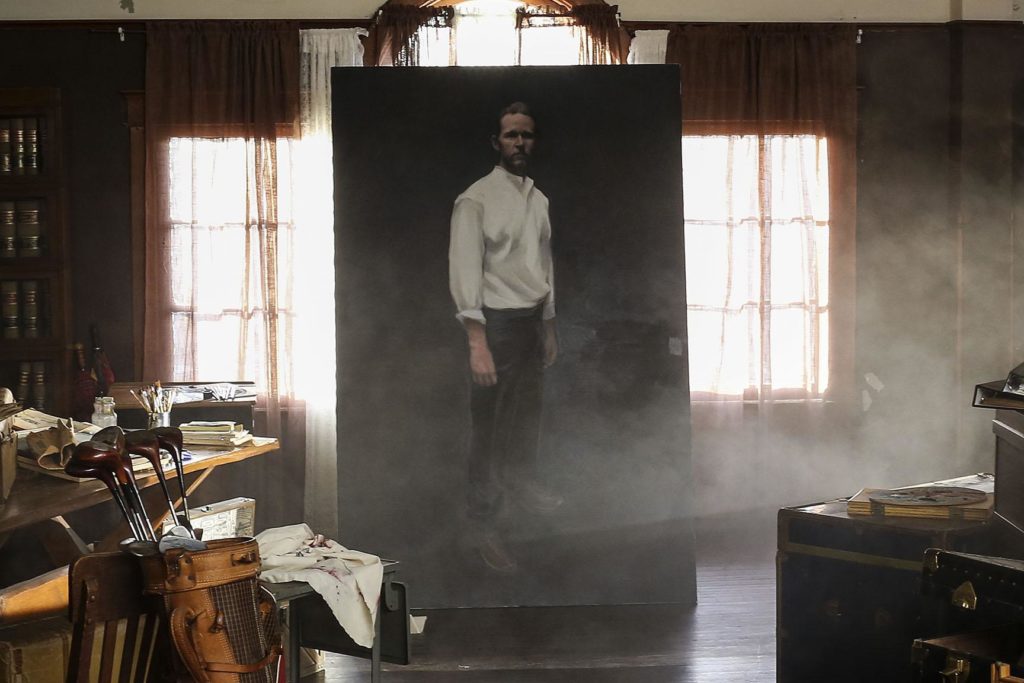
Horror and art: it’s a faithful, longstanding relationship which continues to turn out a few films – good and bad – every single year. And then we come to The Portrait, a film which you could be forgiven for assuming was a fairly straightforward horror story – but it isn’t. Paring back the horror to moments of intense, introspective and even doubtful personal experience, the film turns out to be more of a psychodrama centred upon the plight of an individual. But I said it turns out to be that: the film’s opening scenes are far more in keeping with traditional horror as we witness a young, screaming woman, being dragged bleeding through the woods by a blankly hostile man. As this unfolds, we see a portrait being painted, and we are clearly to infer that something about this creative process is linked to the violence. Then we must store up that information, primed to see this painting reappear at some point later.
We next cut to the modern day, and a couple heading through the hills to a beautiful, remote house – which turns out to be the old family home of the man, Alex (Ryan Kwanten, last seen negotiating with a mysterious entity in a toilet cubicle in Glorious). No rain-lashed, Gothic mansion, this: it’s a pleasant, bright place – but there’s something very wrong with Alex. As his wife Sofia tries to engage with him, he is by turns sullen and reactive; it transpires that he has received a catastrophic brain injury, hence the unpredictable behaviour. And Sofia (the superb Natalia Cordova-Buckley) is doing everything in her power to build a bridge to the man Alex once was: she hopes that spending time in his old house will trigger something, some breakthrough.
We get a few leading clues that the house contains some supernatural presence, mainly as-gleaned by the camera shots from the inside of the house, watching our married couple as they approach the property, and then as they get settled in: is something indeed watching them? Oh, and there’s the small matter of the decidedly unfriendly wall art which greets them inside: here’s our link to the pre-credits. But we spend time with our very much alive protagonists first of all. Alex, it seems, received his injury in the heat of a confrontation with Sofia, which put him in the path of an accident. Sofia, as such wracked with guilt and horror, has made it her life’s work to help him recuperate, and also to do anything within her means to assuage her own feelings (which she harbours needlessly, as the audience is almost certain to infer).
But very much like Miss Giddens in this film’s close relative, The Turn of the Screw, Sofia is bringing a great deal of her own complex emotions and neuroses to bear on her situation. As such, upon exploring the house, she is struck by her discovery of a large portrait in – where else? – the attic. It’s a self-portrait, painted, as she infers, by a previous occupant with a link to this house and – most surprisingly of all – the man in the painting looks uncannily like Alex. In her heightened state of anxiety, this simply compounds her feelings that something awful, something inescapable is heading their way; if the clues were already there, then this discovery serves as some kind of evidence: desperate people often rely on the notion of fate, and the painting feels awfully like fate.
As a few new characters begin to drift in and out of the periphery here, Sofia talks to Alex’s cousin, Mags (Virginia Madsen), who obligingly provides a large slab of backstory on who the man in the portrait is, and what his links are to Alex. It captures Sofia’s imagination: almost on cue, she begins to experience strange visions and dreams, and life in the house becomes ever less bearable. Mags’s story of a tortured, torturing artist concealed somewhere in the family history could be an explanation, of sorts, for the phenomena Sofia begins to suffer through, or else it could just be another weight for Sofia to carry.
The film is strikingly successful in presenting Sofia’s deep, fragile unhappiness and Natalia Cordova-Buckley is absolutely key to this. You really empathise with her lot; she is lonely, vulnerable, and her husband is no longer her husband (though the snippets we see of his behaviour before his accident show us that life was no walk in the park for her beforehand, either). There’s an uncomfortable atmosphere through every second of this film’s runtime, and the sense of dread conveyed is what feels very much like the conduit for the supernatural activity we witness. This happens via some highly effective scenes, doled out very carefully and deliberately – jump scares do not punctuate or define this film. Akin to lots of the very best ghost stories then, events move slowly, always casting doubt on what is happening, hinting at the contextual problems at play here: families; family legacies; the toxic effects of privilege; the lives of women.
The overall of feel of The Portrait is oppressive and claustrophobic: assuming this was the aim for director Simon Ross and writer David Griffiths (who has had a hell of a career shift, from Goldman-Sachs VP to screenwriter) then – well played, this is a hard watch, but a thought-provoking one, with an intriguing and well-developed take on an established horror idea. Whilst not one for fans of high action, for those of you who enjoy pondering the links between human psychology and supernatural phenomena, and pondering them over and over again long after you’ve watched the film, this truly is an unexpected, oblique little gem.
The Portrait (2023) is available now on VOD.
